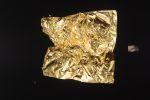EPJ B Highlight - Angling for gold
- Details
- Published on 21 October 2012

A new model provides an alternative description of atomic level gold bonding.
A study on how gold atoms bond to other atoms using a model that takes into account bonds direction has been carried out by physicist Marie Backman from the University of Helsinki, Finland, and colleagues. These findings, which have just been published in EPJB, are a first step toward better understanding how gold binds to other materials through strong, so-called covalent, bonds.
What scientists need is an empirical model, based on a so-called potential, that describes the gold-gold bond in a reliable way. Most previous models only accounted for interactions in the spherical electron density around the atom. Although it is suitable to describe bonds between gold atom pairs, it is not adequate to describe how surface gold atoms bond to other materials. In such a case, the density of interacting electrons is no longer spherical.
Indeed, bond angles matter when gold binds to other materials. Thus, the authors used a model based on potentials with angular dependence, referred to as Tersoff potential. It offers a compromise between including bond directionality, which is needed for covalent bonds, and keeping the computer time needed for the simulations low.
The authors used theoretical and computational analysis to study gold atoms interacting with their neighbours. They fitted their potential functions to the most important observed characteristics of gold, such as gold atoms' lattice constant, binding energy and elastic constants. Thanks to such potential functions they were then able to describe bonding in atomistic simulations. This involves, first, determining the forces on each atom based on their relative positions and second solving equations of motion, to show how the atoms move, on a very short time scale.
Building on this model, future work could, for example, involve the development of cross potentials for gold nanoparticles and nanorods in a matrix, typically used in biomedical imaging and nanophotonics.
Bond order potential for gold. M. Backman, N. Juslin, and K. Nordlund, Eur. Phys. J. B (2012) 85: 317, DOI: 10.1140/epjb/e2012-30429-y




